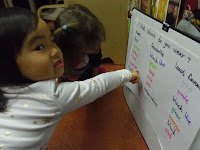Tint & Shade

Tint is adding white to colours to make it lighter Shade is adding black to make colours darker "The yellow disappears! It's lighter" "Hey I made beige! mixing colours is fun "This looks like the forest" Earlier on in the unit the children suggested that colours can be light or dark but they don't know how that happens. In these activities the children explored Tint and Shade by mixing colours. Tint is done by adding some white to the colour making it appear lighter where as shade is when we add black to the colour making it appear darker. As we experimented with our colours the children discovered other colours they knew about like Beige, Navy Blue, Sky Blue, Pink,a and Gray. They also were interested in naming their own colour or asked me to give them the "proper" name for it like Maroon, Olive green and Tan. We are going to apply what we learned about Tint and Shade to our summative assessment project which ...









